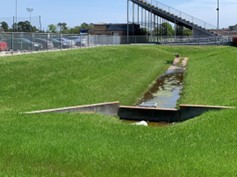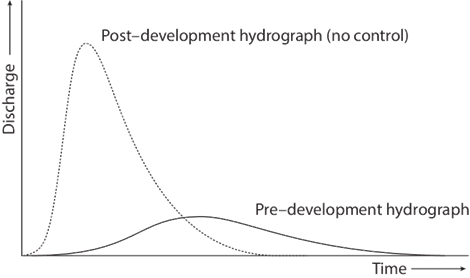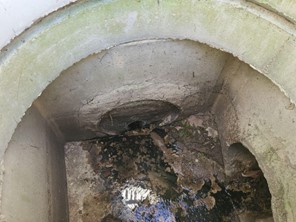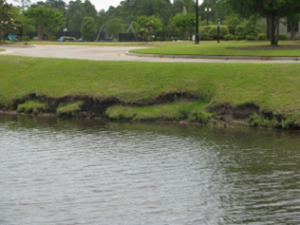 Someone asked me the other day, “What is the question you get asked the most in your industry?”
Someone asked me the other day, “What is the question you get asked the most in your industry?”
The most common question I get from customers is, “What’s the difference between a detention pond and a retention pond…And why do I have one”?
And while it may seem obvious that a detention pond “detains” water and a retention pond “retains” or holds water, the realities of detention and retention are a little more complicated.
Why Do You Need A Detention Pond?
The best place to start is the why rather than the what.
So why do you need a detention pond in the first place?
Detention requirements started in the mid-’80s as a response to urban spread and the addition of more and more impervious areas in the urban landscape. These paved parking lots, building pads, and roadways cause the need.
If we look back to pre-developed conditions, we’ll start to see the big picture. And the best way to do that is to look at a hydrograph showing pre and post-developed conditions.

The easiest way to understand this hydrograph is to envision one single drop of water. Now imagine how long it takes for that drop to travel from, let’s say, the middle of a 5-acre parcel to the ditch out front on the street.
This graph represents all of the rain in a particular event. Hence, as these drops combine and start to flow toward the ditch or storm sewer, we get a peak discharge. As the rain event subsides, so does the amount of water draining off the property.
As you can see in the pre-development line, the rain event starts on the left-hand side. Since the water has to travel across a long, grassy field with dirt and/or vegetation, it moves pretty slowly.
As you’ll notice on the graph, the peak of that pre-developed rain event has minimal impact on the stream, ditch, or sewer that it discharges to. Conversely, in the post-developed scenario, the peak is quick and steep.
This results from that same amount of rain traveling this time across paved parking lots, building rooftops, and storm sewer pipes. Of course, we can’t let that water sit, or it will flood the building and parking lots. So we have to move it into the receiving water body quickly, represented by the post-development hydrograph.
The problem is that if we were to design every construction project to look like the post-development graph, we would quickly inundate the receiving drainage systems owned by the city, county, or state, resulting in localized flooding as well as mass downstream flooding.
Detention ponds are designed to mimic the pre-development hydrograph, reducing the potential for flooding due to paving and installing storm sewers in new developments.
You may not know that all of the ponds you see have a restrictor that is key to mimicking these pre-developed conditions.
 The civil engineer sized the restrictor pipe based on the areas of impervious paving, including buildings, paved parking, and roads, to mimic the pre-developed hydrograph.
The civil engineer sized the restrictor pipe based on the areas of impervious paving, including buildings, paved parking, and roads, to mimic the pre-developed hydrograph.
The restrictor backs rainwater into the pond to “detain” it for 24-72 hours.
This slow, controlled discharge is critical to preventing downstream flooding.
Where Can You Find A Detention Pond?
We’ve partially answered the “What is a Detention Pond” question by answering the why. But the reason why you have one in the first place and the neighbor next door doesn’t is also important to understand.
Remember that detention pond requirements have only been around since the 80s. So if the property in question is older than that, obviously, there won’t be a detention pond. There are also a few cases where the property meets the strict grandfathering requirements, eliminating the need for detention.
Suppose the property is newer than the 80s, hasn’t been grandfathered, and has no detention pond. In that case, the owner has most likely purchased regional detention rights, so their detention is offsite. A regional detention pond is a large pond owned by the MUD (Municipal Utility District), city, or county. Property owners can purchase detention capacity, freeing them to use more of their property for buildings and parking. The MUD maintains the pond, so the property owner has no maintenance or repair responsibilities. They simply pay their fees, and the MUD takes care of the rest.
What Is A Retention Pond?

O.K., so what about retention ponds?
Retention ponds are designed to hold rainwater indefinitely, behaving like a lake or pond. Their purpose is most often as an amenity to beautify the property. Typically located at the front of the site and often including fountains and lighting, these ponds serve no practical purpose like detention ponds.
However, retention ponds usually serve a dual purpose as both detention and retention. We call them combination ponds or wet/dry ponds. The best way to understand a combination pond or dual-purpose pond is to start with a detention pond.
The design of both is nearly identical. Start with a dry pond and dig below the outfall (drainage) pipe. Any space below the outfall pipe becomes retention as the water below the pipe has no way to escape the pond. This is a simplified explanation, the reality being that there are minimum depth requirements and max slope design for both above and below the static waterline.
These are general safety requirements not relevant to our discussion. With the combination pond, we have our detention storage volume in the dry portion of the pond and the wet portion, which serves as a water feature, a.k.a. wet/dry pond.
 Retention ponds, being constantly wet, don’t encounter the same problems as dry ponds do. But they do have their inherent challenges.
Retention ponds, being constantly wet, don’t encounter the same problems as dry ponds do. But they do have their inherent challenges.
If not properly constructed, Cattails (thyrus), Black Willows, and algae can quickly inundate the pond, creating a maintenance nightmare.
Additionally, these ponds often have fountains that create small but constant waves that can erode the pond slopes.
These issues can be mitigated through proper design consideration and construction but are rarely employed, being viewed as unessential to the project and often cut from a design by developers. Unfortunately, that doesn’t address the problem but merely kicks the can down the road, making it property management’s problem to deal with.
The absolute truth is that these problems won’t go away with time. In fact, just the opposite happens. The problems exacerbate, creating additional challenges that will need to be corrected to prevent future failures.
If you would like to learn more about how we can help you with your specific needs please feel free to contact us for a complimentary site assessment. Give us a call today at (832) 554-6654 or email us at info@swpgrp.com
